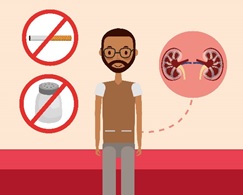
Smoking and Kidney Diseases
Care for your Kidneys series
(Brought to you by MOHAN Foundation & Care for Your Kidney Foundation)
Smoking harms nearly every organ of the body according to Centers for Disease Control and Prevention. Therefore, it is not surprising to learn that smoking also plays a role in the progression of chronic kidney disease (CKD). The first study that showed the connection between smoking and kidney disease was done in 1978. Since then many studies have supported this finding.

Smoking can seriously harm the kidneys in a number of ways. It can:

Kidney disease and its associated complications can kill thats why its so important to stop smoking.
Diabetes and high blood pressure are the two leading causes of CKD. Studies have found that people with diabetes and/or high blood pressure who smoke add to the risk of getting CKD. In both groups smoking increased the chances of getting renal disease. Smoking also accelerated the occurrence of kidney disease. Stopping smoking was shown to help a person maintain kidney function.
Men in the general population, who dont have kidney disease, are at an increased risk for getting end stage renal disease if they are smokers. The risk gets even higher for heavy smokers. Cigarette smoking has been called the most preventable risk factor for maintaining good health. Studies show that in addition to heart disease, cancer and the other diseases attributed to smoking, it has also contributed to renal failure among those who were not kidney disease patients.

How to stop smoking
If you want to stop smoking, you can make small changes to your lifestyle that may help your resist the temptation to light up.
Step 1: Make a plan to quit smoking
Whenever you have decided to stop smoking, make a promise, set a date and stick to it.
Step 2: Get some stop smoking support
It will be easier to quit smoking if you have support from family and friends. Let them know you are trying to quit. They can encourage you to keep going especially, when youre tempted to light up.
Step 3: Stay active
Being active can curb nicotine cravings and ease some withdrawal symptoms. A review of scientific studies has proved exercise, even a 5-minute walk or stretch, cuts cravings and may help your brain produce anti-craving chemicals.

Step 4: Make non-smoking friends
Stick with the non-smokers, when you are at a party.
Step 5: Avoid alcohol and other triggers
When you drink, its harder to stick to your no-smoking goal. So try to limit alcohol when you first quit. Likewise, if you often smoke when you drink coffee, switch to tea for a few weeks. If you usually smoke after meals, find something else to do instead, like brushing your teeth, taking a walk, texting to friend, or chewing gum.

Step 6: Eat fruits and veggies
Dont try to diet while you give up smoking. Too much deprivation can easily backfire. Instead, keep things simple and try to eat more fruits, vegetables, whole grains, and lean protein.

Step 7: Reward your accomplishments.
Quitting is difficult. Going every day without a cigarette is an achievement. Take it step by step, and reward yourself for small successes. In addition to all the health benefits, one of the perks of giving up cigarettes is all the money you will save. Reward yourself by spending part of it on something fun.
#sayNOtoSMOKING
